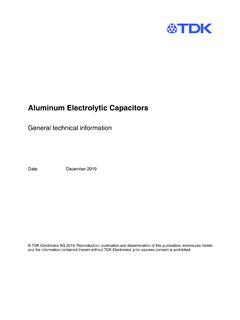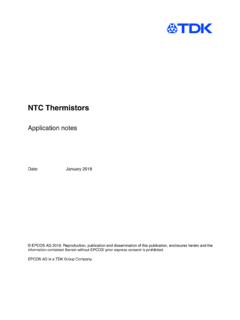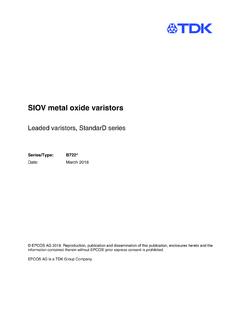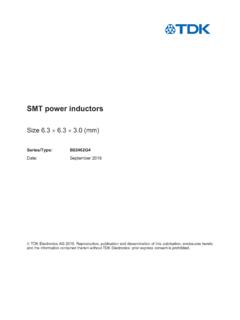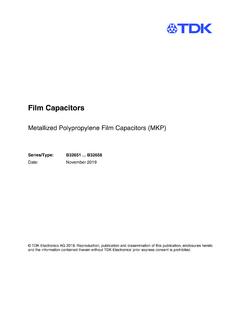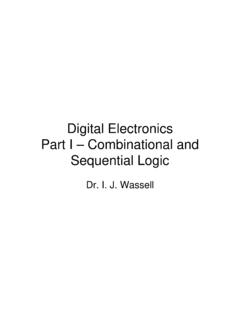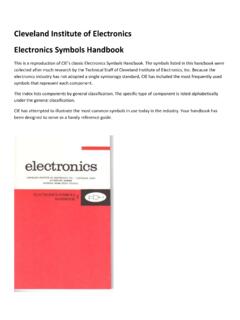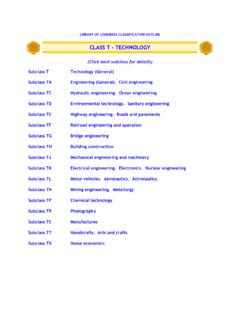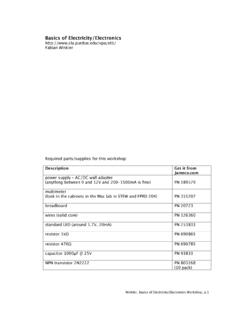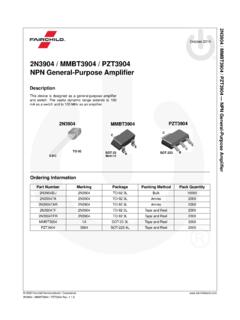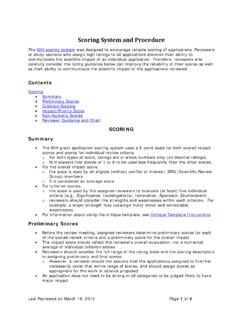Transcription of PTC thermistors, general technical information
1 PTC ThermistorsGeneral technical informationDate:January 2016 EPCOS AG 2016. Reproduction, publication and dissemination of this publication, enclosures hereto and theinformation contained therein without EPCOS' prior express consent is AG is a TDK Group thermistors are ceramic components whose electrical resistance rapidly increases when acertain temperature is exceeded. This feature makes them ideal for use in countless applicationsof modern electrical and electronic engineering, for example as resettable fuses against currentoverload or as shortcircuit protection in motors. PTC thermistors are used in electronic lamp bal-lasts and switch-mode power supplies for delayed switching. You find special motor starter PTCthermistors in the compressors of refrigerators for instance.
2 Thermal protection of motors andtransformers is another example of the versatility of PTC thermistors. The applications extend tomeasurement and control engineering, to entertainment, household and automotive electronics,plus data systems and telecommunications of course. PTC thermistors are also suitable as self-regulating heating elements, in auxiliary heating, nozzle heating and carburetor preheating in au-tomobiles, as well as in many domestic appliances such as door locks for washing machines, orglue guns and hair different models of PTC thermistors from EPCOS are equally diverse, offering the matchingsolution for virtually every application. If you are unable to find the right PTC in this data book,contact one of our sales offices. They will help you, together with the EPCOS development de-partment for PTCs, to find the right solution for your PTC thermistor is a thermally sensitive semiconductor resistor.
3 Its resistance value risessharply with increasing temperature after a defined temperature (reference temperature) hasbeen very high positive temperature coefficient (PTC) of the resistance above the reference tem-perature has given the PTC thermistor its standards are EN 60738-1, IEC 60738-1, DIN 44081 and DIN and functionPTC thermistors are made of doped polycrystalline ceramic on the basis of barium titanate. Gen-erally, ceramic is known as a good insulating material with a high resistance. Semiconduction andthus a low resistance are achieved by doping the ceramic with materials of a higher valency thanthat of the crystal lattice. Part of the barium and titanate ions in the crystal lattice is replaced withions of higher valencies to obtain a specified number of free electrons which make the material structure is composed of many individual crystallites (figure 1).
4 At the edge of thesemonocrystallites, the grain boundaries, potential barriers are formed. They prevent free electronsfrom diffusing into adjacent areas. The result is high resistance of the grain boundaries. However,this effect is neutralized at low temperatures. High dielectric constants and sudden polarization atthe grain boundaries prevent the formation of potential barriers at low temperatures enabling asmooth flow of free the ferroelectric Curie temperature, dielectric constant and polarization decline so far thatthere is strong growth of the potential barriers and thus of resistance. In a certain range of tem- general technical informationPage 2 of 14 Please readImportant notesandCautions and above the Curie temperature TC, the resistance of the PTC thermistor rises exponential-ly.
5 Beyond the range of the positive temperature coefficient the number of free charge carriersis increased by thermal activation. The resistance then decreases and exhibits a negative temper-ature characteristic (NTC) typical of semiconductors (see figure 2).Figure 1 Schematic representation of the polycrystallinestructure of a PTC PTC resistance RPTCis composed ofindividual crystal and grain boundaryresistances. The grain boundary resistance isstrongly temperature Rgrain+ RgrainboundaryRgrain boundary= f (T)Figure 2TC= ferroelectric Curie temperature = temperature coefficientWith rising temperature, the resistance of thePTC thermistor initially decreases and rises thensteeply. Beyond the range of the positivetemperature coefficient the resistance technical informationPage 3 of 14 Please readImportant notesandCautions and propertiesParameterUnitTypical valuePhysical valuesHeat capacitykJ/(kg K)
6 Coefficient10-6/K4 below Tref14 above TrefMechanical strength valuesE modulusGPa100 below Tref180 above TrefShear modulus GGPa40 below Tref70 above TrefWeibull bending tensilestrengthMPa100 Weibull compressivestrengthMPa500 Weibull tensile strengthMPa504 ManufacturingMixtures of barium carbonate, titanium oxide and other materials whose composition producesthe desired electrical and thermal characteristics are ground, mixed and compressed into disks,washers, rods, slabs or tubular shapes depending on the blank parts are then sintered, preferably at temperatures below 1400 C. Afterwards, theyare carefully contacted, provided with connection elements depending on the version and finallycoated or technical informationPage 4 of 14 Please readImportant notesandCautions and flow chart in the quality section (chapter "Quality and environment") of this book shows the indi-vidual processing steps in detail.
7 The chart also illustrates the extensive quality assurance mea-sures taken during manufacture to guarantee the constantly high quality level of our current flowing through a thermistor may cause sufficient heating to raise the thermistor's tem-perature above the ambient. As the effects of self-heating are not always negligible, a distinctionhas to be made between the characteristics of an electrically loaded thermistor and those of anunloaded thermistor. The properties of an unloaded thermistor are also termed "zero-power char-acteristics". PTC dependence of resistanceThe zero-power resistance value R (T) is the resistance value measured at a given temperature Twith the electrical load kept so small that there is no noticeable change in the resistance value ifthe load is further test voltages, please refer to the individual types (mostly V).
8 Figure 3 shows the typical dependence of the zero-power resistance on temperature. Because ofthe abrupt rise in resistance (the resistance value increases by several powers of ten), the resis-tance value is plotted on a logarithmic scale (ordinate) against a linear temperature scale(abscissa).Figure 3 Typical resistance/temperature characteristicRPTC= f (TPTC)RRRated PTC resistance(resistance value at 25 C)RminMinimum resistanceTRminTemperature at RminRrefReference resistanceRref= 2 RminTrefReference temperature(resistance value reachesRref= 2 Rmin) general technical informationPage 5 of 14 Please readImportant notesandCautions and resistance RRThe rated resistance RRis the resistance value at temperature TR. PTC thermistors are classifiedaccording to this resistance value.
9 The temperature TRis 25 C, unless otherwise resistance RminThe beginning of the temperature range with a positive temperature coefficient is specified by thetemperature TRmin. The value of the PTC resistance at this temperature is designated as Rmin. Thisis the lowest zero-power resistance value which the PTC thermistor is able to assume. Rminis of-ten given as a calculable magnitude without stating the corresponding temperature. The Rminval-ues specified in this data book allow for the R tolerance range of the individual types and repre-sent the lower PTC heaters the Rminvalues given in the data sheet section are measured at the rated resistance Rrefat reference temperature TrefThe start of the steep rise in resistance, marked by the reference temperature Tref, which corre-sponds approximately to the ferroelectric Curie point, is significant for the application.
10 For the indi-vidual types of PTC thermistors it is defined as the temperature at which the zero-power resis-tance is equal to the value Rref= 2 Rmin. In the data sheet section we specify typical values of coefficient The temperature coefficient of resistance is defined as the relative change in resistance re-ferred to the change in temperature and can be calculated for each point on the R/T curve by:In the range of the steep rise in resistance above Rref, may be regarded as being approximatelyconstant. The following relation then applies:Within this temperature range, the reverse relation can be equally applied:The values of for the individual types relate only to the temperature range in the steep region ofthe resistance curve, which is of primary interest for many technical informationPage 6 of 14 Please readImportant notesandCautions and temperature TsenseFor PTC temperature sensors the pair of values Tsense, Rsenseis specified instead of Tref, Rref.

